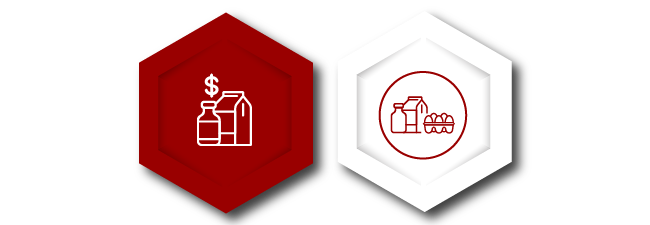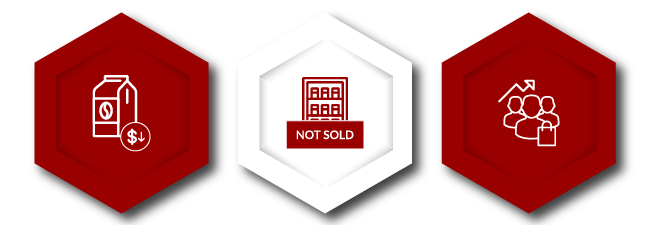As far as pricing strategies go, the one that you could describe as the most shopper-friendly is bundle pricing. At least, that is how you want to portray it. Because, as much as it is a pricing strategy, you could also argue that it's aimed at creating a perception. In that sense, it could come across as a misleading strategy. However, that is far from the truth.
In reality, bundle pricing offers opportunities to both yourself and your shoppers, all positive. More than that, there are good reasons why it’s worth investing in.

What is bundle pricing?
Bundle pricing is an effective strategy for you to use in-store. You can see that by considering its definition. Fortunately, it’s a straight-forward approach that needs little explanation.
In simple terms, it’s a strategy you would use to bundle two or more products together in-store and then offer them at a discount. That’s why you might also hear people refer to it as product bundling.
Considering the explanation, it’s easy to see why you’d label it as that. Both offer value to your customers. But, we’d like to argue that there is a distinction between the two, however slight. You can find that difference in the intent behind each.
For example, bundle pricing is about grouping products with the aim of offering a discount. That’s up to your sales and profitability. Also, while it’s worth offering products from within the same grouping, you are not bound to that - you can bundle products from different categories.

Bundle Pricing vs Product Bundling?
The two can easily be confused but they are not the same. Product bundling focuses on packaging items with the goal of offering shoppers an all-in-one solution. It works best when these items are all within the same category.
Here’s a practical example: with bundle pricing, if you’re an FMCG retailer, you could offer customers a deal in which they can purchase Coffee and Milk together at a lower price than if they buy each separately. Alternatively, if you sell high-end electronics, you could offer Cable at a discounted rate if a customer buys a specific television brand. You could team up with your suppliers to provide such a deal.
For product bundling, let’s look at Shaving products as an example.
If a customer walks in looking for Shaving Cream, you could offer a bundle that has this item plus a Razor, Aftershave and any other items that your customer would need. In that sense, you’re looking at whether the product bundle solves your customer’s problem or not.
If it fails to solve the problem, you need to question the set up of your bundle and tweak it where necessary.

Why should you follow a bundle pricing strategy?
Knowing what a bundle pricing strategy is should not be the deciding factor in persuading you to implement it in-store. It’s the benefits that should do that.
Mind you; there are also disadvantages to this approach.
The first advantage is that this strategy provides more value to your customers as you’re offering multiple products at a discounted rate. The direct result is happier customers who feel as if they’re getting more for their money.
Of course, there is a side effect to this, which comes back to the perception that you’re attempting to create. While you might want shoppers to view the deal as valuable, a possible disadvantage is that they might see it as an attempt by you to get rid of inferior products. Thus, when bundling products and pricing them down, you must ensure that both items can stand up to scrutiny on their own.
A second advantage is that it reduces buyer hesitancy. While shoppers rightly question buying expensive products, when you tie it to another product, thereby adding value to the overall purchase, it makes for an easier sell.
There is, of course, a disadvantage to this. It’s if you fail to bundle the products at the right price. If customers don’t see value in the purchase as you do, there is a high possibility that instead of making a profit, you’ll make a loss.
Thirdly, and this is the most apparent advantage of following this strategy. That is, it can result in an increase in your sales and profit. How? As much as you’re selling products at a discount, it’s the volume of sales that leads to the increase. When priced right, you’re balancing out any potential loss suffered by discounting a product with the additional sales.
The last disadvantage to bundle pricing isn’t so much a fixed issue. By that, we mean it’s possible to bypass it altogether. Here’s the negative: by pairing specific products at a discount, shoppers don’t have an option to buy each item individually. By purchasing the deal, while they’re getting one product they do want; they’re getting another they they might not want. It’s the low price that has them buying it.
It’s easy enough to circumvent this problem by giving shoppers the option to buy these items individually. The reality of that is that then it is no longer a discount. It’s not longer a bundled price. However, you at least give customers options. And that can mean the difference between them buying at your store or choosing your direct competitor.

When should you follow a bundle pricing strategy?
By now you have a better idea of what bundle pricing is, what it could look like in-store and why you should consider it. Of course, it’s not always a worthwhile approach for you to take. It’s crucial that you first consider what it is you want to achieve before attempting any strategy.
That said, there are specific instances where it makes sense to follow it.
Below, we pinpoint three such occasions. If you’re considering following this strategy, these are the moments that would best suit them.
1. If you have a product that doesn’t sell well on its own
There is every chance that a product you stock in-store doesn’t sell as well as you hoped when you first introduced it. That could be because of a multitude of reasons.
A primary reason is that you didn’t consider your customers when you first introduced the product. For example, you may stock a specialist coffee brand, which retails at a high price. However, the shoppers who frequent your store don’t come for specifically for coffee but rather for other products. Also, they are price-sensitive.
But that shouldn’t discourage you from stocking the product. It’s merely a case of finding a way to package it so that you can still sell it. One such opportunity is to bundle it with another item that you stock. It helps if you package it with a popular product or one that your customers already buy regularly.
What’s more, it lowers buyer hesitancy while adding value, two points which we’ll dig into later on in this piece.
2. If you have unsold stock and you want to get rid of it
A second reason to use bundle pricing in your store is that it offers you an ideal opportunity to get rid of any stock that you can’t sell.
Here, we’re referring specifically to deadstock, be that on your shelves or in your storeroom.
There is the argument that you could send such items back to your suppliers. In some cases, it’s worth doing that. However, it’s not always the best option. And especially not if you find that you’re regularly returning unsold stock. That’s a surefire way to damage any relationship with your supplier.
You need to find another way to move it. Again, offering it at a lower price bundled with another product is one approach that you can take. The benefit is that you open up the opportunity to make money on a product that otherwise might have cost you money to hold, thereby upping your carrying costs unnecessarily.
Let’s use the same coffee example that we used above. You found that the specialist coffee brand isn’t moving at all and so you’ve placed it to your storeroom to make space for another product that does sell. Instead of leaving it in your storeroom to gather dust, you can repackage it with another product and offer it as a once-off deal.
Adding a marketing spin to it, you could present it as a ‘while stocks last’ deal, upping the ante to create excitement for it.
3. If you want to create demand for a little-known or new product
While we’ve mentioned two instances where bundle pricing can help you to correct any errors with your product assortment, it’s not only for hiding your mistakes.
It’s just as valid a strategy to use to create demand for a little-known product. Alternatively, to highlight or promote an item that you’ve recently introduced.
Let’s consider the little-known product first. By packaging such a product together with a well-known or popular product, you’re attracting attention to it.
For example, you’ve stocked Product X for a few months now, and you notice that sales aren’t where they should be. There is no doubt that the category in which you’ve placed it is making sales because your data reflects so. What’s more, you know that if given a chance, Product X will sell well if not better than the other products within the category.
It would be the perfect opportunity to bundle it with another well-known product. Better yet, you could pair it with a product from another category to show customers how to use it, thereby creating demand for it. If you’ve done this correctly, there is every chance of customers returning to buy the product when it’s one bundled together.
As for highlighting or promoting a new product, it's an effective method. After all, if you want to introduce new products into your store, one of the most compelling strategies is to offer it at a discount in the hopes of first creating interest and then customer demand.
Conclusion
DotActiv Lite, Pro, and Enterprise are all different versions of our category management software that allows you to drive category performance. You can visit our online store here.


